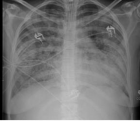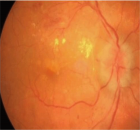Abstract
Review Article
Management of Ischemic Stroke during cardiac catheterization: A case report and review of literature
Naoufal Chouaib*, Said Jidane, Mounir Lekhlit, Ahmed Belkouch, Tahir Nebhani, Saad Zidouh and Lahcen Belyamani
Published: 22 August, 2019 | Volume 4 - Issue 1 | Pages: 040-041
Stroke following coronary interventions is a devastating and most dreaded complication with signiβicant morbidity and mortality. Various factors have been ascribed for this complication including the technical errors [1]. A small percentage of strokes are iatrogenic, including those associated with invasive cardiac procedures. According to the literature, it is a rare complication of left heart catheterization [2]. Percutaneous coronary intervention is increasingly used to treat patients with diffuse atherosclerosis, acute coronary syndromes and even high-risk patients such as low ejection fraction [1]. The authors describe a patient who underwent percutaneous coronary intervention in the context of inferior infarction, which was complicated by ischemic stroke during cardic catheterization.
Read Full Article HTML DOI: 10.29328/journal.jcicm.1001024 Cite this Article Read Full Article PDF
References
- Sanket KM, Anand BS. Ischaemic Stroke Following Percutaneous Transluminal Coronary Angioplasty (PTCA): A Rare Complication Cardiology. Journal of Clinical and Diagnostic Research. 2014; 8: 1-2.
- Magno P, Loureiro J, Marques A, Abreu PF, Candido M, et al. AVC isquémico pericateterismo cardíaco: a propósito de um caso clínico. Rev Port Cardiol. 2007; 26: 1033-1040.
- Fuchs S, Stablile E, Kinnaird TD, Mintz GS, Gruberg L, et al. Stroke complicating percutaneous coronary interventions: incidence, predictors, and prognostic implications. Circulation. 2000; 106: 86-96. PubMed: https://www.ncbi.nlm.nih.gov/pubmed/12093775
- Segal AZ, Abernethy MW, Palacios IF, BeLue R, Rordorf G. Stroke as a complication of cardiac catheterization: risk factors and clinical features. Neurology. 2001; 56: 975-977. PubMed: https://www.ncbi.nlm.nih.gov/pubmed/11294941
- Leker RR, Pollak A, Abramsky O, Ben-Hur T. Abundance of left hemispheric embolic strokes complicating coronary angiography and PTCA. J Neurol Neurosurg Psychiatry. 1999; 66: 116-119. PubMed: https://www.ncbi.nlm.nih.gov/pubmed/9886472
- Cronin L, Mehta SR, Zhao F, Pogue J, Budaj A, et al. Stroke in relation to cardiac procedures in patients with non–ST-elevation acute coronary syndrome: a study involving >18,000 patients. Circulation 2001; 104: 269-276. PubMed: https://www.ncbi.nlm.nih.gov/pubmed/11457743
- Pettolot G, Bracco J, Barrillon D, Baudouy M, Morand P. Cholesterol embolization. Unrecognized complication of thrombolysis. Circulation. 1998; 97: 15-22. PubMed: https://www.ncbi.nlm.nih.gov/pubmed/9576434
- Dukkipati S, O’Neill WW, Harjai KJ. Characteristics of cerebrovascular accidents after percutaneous coronary interventions. J Am Coll Cardiol. 2004; 43: 1161-1167. PubMed: https://www.ncbi.nlm.nih.gov/pubmed/15063423
- Pooja Khatri, Robert A, Taylor, MD. The Safety and Efficacy of Thrombolysis for Strokes after Cardiac Catheterization. J Am Coll Cardiol. 2008; 51: 906-911. PubMed: https://www.ncbi.nlm.nih.gov/pubmed/18308158
- NINDS rt-PA Stroke Study Group. Tissue plasminogen activator for acute ischemic stroke. N Engl J Med. 1995; 333: 1581-1587.
Similar Articles
-
Phenibut Overdose in Combination with Fasoracetam: Emerging Drugs of AbuseCristian Merchan*,Ryan Morgan,John Papadopoulos,David Fridman. Phenibut Overdose in Combination with Fasoracetam: Emerging Drugs of Abuse. . 2016 doi: 10.29328/journal.jcicm.1001001; 1: 001-004
-
Nursing Care of ICU Patients Lightly Sedated with DexmedetomidineÅsa Engström*,Maria Johansson,Mia Mattsson,Ulrica Strömbäck. Nursing Care of ICU Patients Lightly Sedated with Dexmedetomidine. . 2016 doi: 10.29328/journal.jcicm.1001002; 1: 005-013
-
Complicated Hepatitis A Virus Infection: A Report of Three Cases from Single Tertiary Referral CenterOmkolsoum M Alhaddad,Maha M Elsabaawy*,Khalid A Gameel,Marwa Elfauomy,Olfat Hendy,Eman A Rewisha. Complicated Hepatitis A Virus Infection: A Report of Three Cases from Single Tertiary Referral Center. . 2016 doi: 10.29328/journal.jcicm.1001003; 1: 014-020
-
Critical Management of Status EpilepticusFarahnaz Fallahian*,Seyed MohammadReza Hashemian*. Critical Management of Status Epilepticus. . 2017 doi: 10.29328/journal.jcicm.1001004; 2: 001-015
-
Comparative Hemodynamic Evaluation of the LUCAS® Device and Manual Chest Compression in Patients with Out-of-Hospital Cardiac ArrestMirek S,Opprecht N*,Daisey A,Milojevitch E,Soudry- Faure A,Freysz M. Comparative Hemodynamic Evaluation of the LUCAS® Device and Manual Chest Compression in Patients with Out-of-Hospital Cardiac Arrest. . 2017 doi: 10.29328/journal.jcicm.1001005; 2: 016-024
-
Chemotherapy Exposure and outcomes of Chronic Lymphoid Leukemia PatientsJosephina G Kuiper*,Patience Musingarimi,Christoph Tapprich,Fernie JA Penning-van Beest,Maren Gaudig. Chemotherapy Exposure and outcomes of Chronic Lymphoid Leukemia Patients. . 2017 doi: 10.29328/journal.jcicm.1001006; 2: 025-033
-
Knowledge, attitude and practices associated with diagnosis and management of Skin and Soft Tissue Infections (SSTIs) among Pediatric Residents and Physicians in a Tertiary Hospital in United Arab Emirates (UAE)Eiman Al Blooshi,Farah Othman,Abeer Al Naqbi,Majid Al Rumaithi,Khawla Fikry,Mariam Al Jneibi,Hossam Al Tatari*. Knowledge, attitude and practices associated with diagnosis and management of Skin and Soft Tissue Infections (SSTIs) among Pediatric Residents and Physicians in a Tertiary Hospital in United Arab Emirates (UAE) . . 2017 doi: 10.29328/journal.jcicm.1001007; 2: 034-039
-
Unusual presentation of a bilateral basilar stroke: BradycardiaZidouh S*,Jidane S,Nabhani T,Chouaib N,Sirbou R,Belkouch,Belyamani L. Unusual presentation of a bilateral basilar stroke: Bradycardia. . 2017 doi: 10.29328/journal.jcicm.1001008; 2: 040-041
-
Sinking Skin Flap SyndromeLiew BS*,Rosman AK,Adnan JS. Sinking Skin Flap Syndrome. . 2017 doi: 10.29328/journal.jcicm.1001009; 2: 042-048
-
Intensive Care Units (ICU): The clinical pharmacist role to improve clinical outcomes and reduce mortality rate- An undeniable functionLuisetto M*,Ghulam Rasool Mashori. Intensive Care Units (ICU): The clinical pharmacist role to improve clinical outcomes and reduce mortality rate- An undeniable function. . 2017 doi: 10.29328/journal.jcicm.1001010; 2: 049-056
Recently Viewed
-
Sinonasal Myxoma Extending into the Orbit in a 4-Year Old: A Case PresentationJulian A Purrinos*, Ramzi Younis. Sinonasal Myxoma Extending into the Orbit in a 4-Year Old: A Case Presentation. Arch Case Rep. 2024: doi: 10.29328/journal.acr.1001099; 8: 075-077
-
In vitro, Anti-oxidant, and Anti-inflammatory Activity of Kalanchoe pinnataWijeratne Mudiyanselage Swarna Menu*. In vitro, Anti-oxidant, and Anti-inflammatory Activity of Kalanchoe pinnata. Arch Pharm Pharma Sci. 2025: doi: 10.29328/journal.apps.1001064; 9: 001-008
-
Green Synthesis of Citrus sinensis Peel (Orange Peel) Extract Silver Nanoparticle and its Various Pharmacological ActivitiesJ Bagyalakshmi,M Prathiksha. Green Synthesis of Citrus sinensis Peel (Orange Peel) Extract Silver Nanoparticle and its Various Pharmacological Activities. Arch Pharm Pharma Sci. 2025: doi: 10.29328/journal.apps.1001065; 9: 009-013
-
Artificial Intelligence in the Pharmaceutical Galenic Field: A Useful Tool with Associated RisksLuisetto M*,Ferraiuolo A,Fiazza C,Cabianca L,Edbey K,Mashori GR,Abdul Hamid G,Latyshev Oleg Yurevich. Artificial Intelligence in the Pharmaceutical Galenic Field: A Useful Tool with Associated Risks. Arch Pharm Pharma Sci. 2025: doi: 10.29328/journal.apps.1001066; 9: 014-020
-
Large odontogenic tumor in CongoGottfried Lemperle*,Christoph Sachs,Katja Kassem-Trautmann,Carsten Schröder,Jörg Kalla. Large odontogenic tumor in Congo. J Oral Health Craniofac Sci. 2022: doi: 10.29328/journal.johcs.1001036; 7: 001-004
Most Viewed
-
Sinonasal Myxoma Extending into the Orbit in a 4-Year Old: A Case PresentationJulian A Purrinos*, Ramzi Younis. Sinonasal Myxoma Extending into the Orbit in a 4-Year Old: A Case Presentation. Arch Case Rep. 2024 doi: 10.29328/journal.acr.1001099; 8: 075-077
-
Evaluation of Biostimulants Based on Recovered Protein Hydrolysates from Animal By-products as Plant Growth EnhancersH Pérez-Aguilar*, M Lacruz-Asaro, F Arán-Ais. Evaluation of Biostimulants Based on Recovered Protein Hydrolysates from Animal By-products as Plant Growth Enhancers. J Plant Sci Phytopathol. 2023 doi: 10.29328/journal.jpsp.1001104; 7: 042-047
-
Feasibility study of magnetic sensing for detecting single-neuron action potentialsDenis Tonini,Kai Wu,Renata Saha,Jian-Ping Wang*. Feasibility study of magnetic sensing for detecting single-neuron action potentials. Ann Biomed Sci Eng. 2022 doi: 10.29328/journal.abse.1001018; 6: 019-029
-
Physical activity can change the physiological and psychological circumstances during COVID-19 pandemic: A narrative reviewKhashayar Maroufi*. Physical activity can change the physiological and psychological circumstances during COVID-19 pandemic: A narrative review. J Sports Med Ther. 2021 doi: 10.29328/journal.jsmt.1001051; 6: 001-007
-
Pediatric Dysgerminoma: Unveiling a Rare Ovarian TumorFaten Limaiem*, Khalil Saffar, Ahmed Halouani. Pediatric Dysgerminoma: Unveiling a Rare Ovarian Tumor. Arch Case Rep. 2024 doi: 10.29328/journal.acr.1001087; 8: 010-013

HSPI: We're glad you're here. Please click "create a new Query" if you are a new visitor to our website and need further information from us.
If you are already a member of our network and need to keep track of any developments regarding a question you have already submitted, click "take me to my Query."


















































































































































